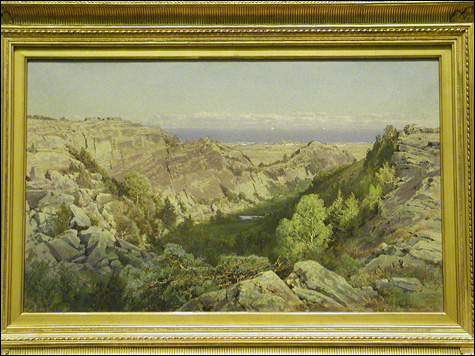
A LANDMARK WORK: Williams’s Paradise Valley, Middletown, Rhode Island.
|
This is the Ocean State, after all, with some 400 miles of shoreline, so it’s only natural that Rhode Island artists have also been attracted to the coast of Maine. The Newport Art Museum is presenting two shows that combine the settings, “Maine and Rhode Island from the Collection” and “Water to Water: Maine and Rhode Island in the Paintings of David Dewey.”
Both seascapes and landscapes are implied by the titles, and choosing works from two locations widens the possible selections. In the permanent collection exhibition, the result is an array of nearly three dozen gems.
Watercolor allows a wide variety of expression and impression, so the medium predominates in depictions of land and sea. Diaphanous washes evoke bucolic tranquillity; translucent colors simulate light more directly than do opaque oil paints. The full spectrum of possible effects are on display here. Notable is an 1881 painting by William Trost Williams, Paradise Valley, Middletown, Rhode Island, featured in its gilt frame beneath the title of the exhibition. The artist was prominent in the American Watercolor Society in raising the status of watercolor as a medium, which he combined with denser gouache to accomplish the same sharp definitions possible in oils. But the painting’s light-struck trees glow against their shadow background, illuminated as only translucent paint allows.
The exhibition is informative, providing well-chosen commentary and background on some of the works. We learn that Sydney Burleigh was lauded as the “dean of Rhode Island artists” by the Brown University president of the time. So we know that in a circa 1900 painting of his Little Compton farm, the mottled gray sky, not pretty but visually interesting, was appreciated; by that time, audiences for watercolors apparently were ready for more than postcard pictorialism. A wall card next to a painting by Wolf Kahn of a Maine harbor details how the artist’s style evolved from the expressionism of his native Germany to the soft tonal shadings of the New England landscapes with which he became associated.
Of course, most of these works are interesting as visual encounters more than as educations. The raw expressionism of Florence Leif’s charcoal drawing, Lake McGrath, Maine, makes the German origins of her style far less significant than the impact of the wind-peaked water merging with equally angular rocks. Autochromes from the first decade of the 20th century, photographed by John J. Mason, are interesting as skillful compositions — flower-hatted women sitting in a garden, another woman seated next to a boulder in the Paradise Valley of the above painting by Williams — even if we don’t learn that the popular photographic process placed transparent images on glass. In The Racing Tide (ca. 1920), an etching by Charles H. Woodbury, his use of lines exclusively, without any cross-hatched shading, speaks for itself: a small boat in the middle distance looks threatened by the violently roiling water in the foreground, while in the far background a gentle sky is established by faint horizontal lines.
The second show, “Water to Water: Maine and Rhode Island in the Paintings of David Dewey,” is even more extensive, although it showcases only one artist. Dewey first set his professional eyes on this state in the late ’90s. Before then he was known mostly for his watercolors of the coast of Maine. The museum has his painting Second Beach (2003) in its permanent collection. Its serenity of composition is typical of his style. Under the color modulations of a sunset sky, triangles and strips of water and land stack and interlock. The best of his paintings here are the simplest ones. In Second Beach with Poles (2003), utility poles and fence posts stand against a pale dawn sky, rising out of shadowy foreground. Dewey shows a photographer’s fascination with tonal qualities in Last Light (2004) and Day’s End (2004), both studying how shadows change the geometry and mood of the same white clapboard façade.
In the last two years, his work has become minimalist, less anchored by objects or architecture. In Sole Mooring (2004), a small, solitary fishing boat in the lower left is the only realistic touch in an impressionistic study of glowing sunset sky and calm ocean. Winter Harbor (2005) would look like an homage to abstract expressionist Mark Rothko, with its massive cloudless sky above a thin strip of water, if it weren’t for a modest rise of land at the lower right, turning it representational. Sky and City:
Summer Haze (2005), composed of a long rectangle of pale blue above darker blue, would lose all reference to outward reality if it weren’t for its title.
“Maine and Rhode Island from the Collection” + “Water to Water: Maine and Rhode Island in the Paintings of David Dewey” | Newport Art Museum, 76 Bellevue Ave, Newport | Through Jan 29